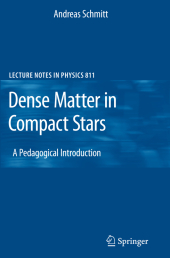 Neuerscheinungen 2010Stand: 2020-01-07 |
Schnellsuche
ISBN/Stichwort/Autor
|
Herderstraße 10
10625 Berlin
Tel.: 030 315 714 16
Fax 030 315 714 14
info@buchspektrum.de |

Andreas Schmitt
Dense Matter in Compact Stars
A Pedagogical Introduction
2010. x, 147 S. 23 SW-Abb. 235 x 155 mm
Verlag/Jahr: SPRINGER, BERLIN 2010
ISBN: 3-642-12865-3 (3642128653)
Neue ISBN: 978-3-642-12865-3 (9783642128653)
Preis und Lieferzeit: Bitte klicken
This text addresses the strongly coupled issues of the nature of the ground state and properties of dense (quark) matter, as well as the matter composition of a compact star. The calculations are physically motivated, helping the reader to ´learn by doing´.
The purpose and motivation of these lectures can be summarized in the following two questions: - What is the ground state (and its properties) of dense matter? - What is the matter composition of a compact star? The two questions are, of course, strongly coupled to each other. Depending on your point of view, you can either consider the ?rst as the main question and the second as a consequence or application of the ?rst, or vice versa. If you are interested in fundamental questions in particle physics you may take the former point of view: you ask the question what happens to matter if you squeeze it more and more. This leads to fundamental questions because at some level of suf?cient squeezing you expect to reach the point where the fundamental degrees of freedom and their interactions become important. That is, at some point you will reach a form of matter where not molecules or atoms, but the constituents of an atom, namely neutrons, protons, and electrons, are the relevant degrees of freedom.
Mass and Radius of the Star.- Basic Models and Properties of Dense Nuclear Matter.- Superconductivity and Superfluidity in a Compact Star.- Neutrino Emissivity and Cooling of the Star.- Discussion.


